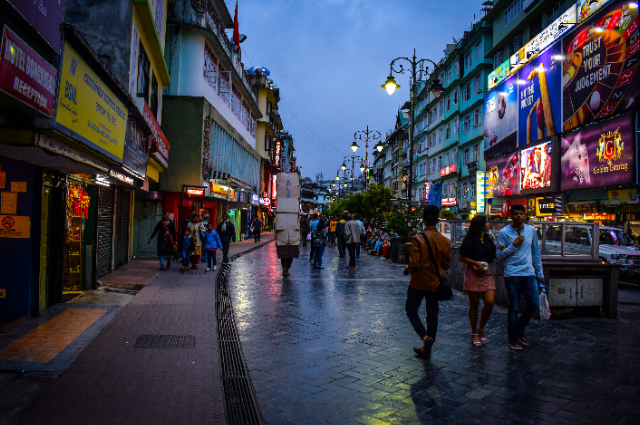
Photo by POOJAN THANEKAR on Unsplash
Introduction
Footpaths are the vital components of roads from the beginning of road construction in India in the modern form of black-top surface. Without them, the road is perceived to be incomplete. On the one hand, it provides a safe and free passage to the pedestrians, and otherwise, it provides strength to the constructed road. Footpaths are mainly used for travelling on foot day and night. Besides, they are also used for the purposes of morning and evening walks for maintaining good health for the citizens. In the present times, roads are mainly occupied by the moving vehicles such as motor cars, trucks, private and government buses, etc. It becomes impossible to cross the road without taking sufficient precautions. At the same time, it is just inconceivable to walk on the road on foot. There is so much traffic on the road. Hence, it becomes imperative on the part of the government machinery to construct pavements or footpaths for the pedestrians, so that their movement is not restricted. At present, the existing narrow roads are being widened to handle the increasing traffic pressure. While doing so, footpaths are not developed simultaneously, and often discarded with an objective to provide more space to the running vehicles which is not desirable at all.
Footpaths as Vending Zones
However, the other problem related to footpaths is more acute. Wherever the footpaths exist, the process of illegal encroachment starts and it grows rapidly. Footpaths wholly or its major parts are thus converted into the veritable "vending zones". All kinds of merchandise are placed on the footpaths to attract customers at first site. The passers-by invariably stop at such vending zones to purchase different articles of their choice. Though legally, such encroachment is not permitted, it happens with the tacit concurrence of the municipal and police authorities. In allowing this encroachment, hush money often plays an important role. There exists both the temporary and permanent structures on the footpaths. Besides that, at some places, the municipal authorities plant trees on the footpaths. That restricts the already limited space available within the footpath area.
As a result, people find it difficult to move freely on the footpaths. Sometimes, an official drive is initiated to remove such encroachments, but after a while, they again come up on their fixed places. There appears to be no routine or regular programme to remove encroachments on the footpaths. Not only this, such encroachers are issued receipts of proper allotment fees as prescribed in the Municipal Act and the Bye-laws by the municipal staff. This documentary evidence helps them in the civil courts to fight their cases against such anti-encroachment drives. There is no gainsaying to reiterate that all these receipts are illegal. Consequently, the footpaths are fast losing their existence. They are turning into an extension of the market adjacent to the road.
"Right to Walk"
Last year in 2022, the Supreme Court of India held in a case that every citizen has a "right to walk " safely on the roads. Therefore, all the state governments should ensure safe passage on roads for the people. To achieve this objective, footpaths should be constructed for the pedestrians and the cycle tracks should be made for the cyclists. That is an ideal situation but its implementation is an uphill task. Recently,in the first week of May 2023, Punjab became the first state in India to implement Supreme Court's order by according the "right to walk" on roads safely on all the citizens traveling on the roads as pedestrians. The Chief Secretary of Punjab has issued directions to the Traffic Consultant of the state to take further necessary steps in this regard. In the state of Uttar Pradesh also, the government orders were issued and the Allahabad High Court passed similar orders in the past, but no concrete action could be initiated in implementing the Apex Court's orders in true spirit.
The Municipal Corporation Act, 1959
In U.P., the Section 259 of the Municipal Corporation Act,1959 holds that it should be ensured that no encroachment takes place on the footpaths, and if it occurs, that will be removed by the municipal authorities as soon as possible. No prior notice is required to be given to the encroacher in this regard. This is almost true in all other Municipal Acts of different States. But nothing happens in permanent terms. The vendors encroach the space on the footpaths, they are removed often for a short period, and then they again occupy the land as usual. No serious effort is made to break this vicious circle.
Conclusion
It has to be kept in mind by everyone that every citizen has a right to walk on the footpaths. In fact, this is their fundamental right. The Apex Court has reemphasized this fact in its judgment of last year. If the pavements and footpaths are not cleared permanently for the travellers, the people falling into the category of senior citizens will be forcefully confined to their homes which is not beneficial to their physical and mental health. It will also be dangerous for the children also to come out on the roads where there is no place for pedestrians to walk freely and safely. Footpaths are the essential segment of modern traffic management systems. Moreover, they are the outlets to see and experience the outside world. If they vanish, it would be very difficult to survive for the humans as nobody can remain confined within the four walls of his or her house for long. It is high time, therefore, to make strict rules to effectively check the menace of footpath encroachment in the future. The implementation of the rules has to be done in true spirit. Footpaths play a multiple role in our life and we need to understand this basic fact. The municipal authorities as well as the people at large should be more vigilant and the encroachers should not be allowed any leeway in this regard.
